Quick update on the go match: AlphaGo won game two and leads, 2-0. Lee Sedol sounds pretty discouraged. I think he may be beaten psychologically, which makes his chances of coming back to win the match slim to none.
And now, back to chess and to my own struggles against the silicon opponent. Unlike Mr. Sedol, I’m playing against a program that can be intentionally weakened.
I’d like to show you two of my recent games with Shredder that are practically twins. They had the same opening, and in both games I sacrificed the same piece on the same square. The outcomes were rather different, though. In the first game the sacrifice was sound and should have led to a beautiful victory. But I overlooked a (not very difficult) followup and had to settle for a perpetual check. In the second game, the sacrifice was only good enough to equalize, but the computer made a horrific blunder and I won. It was sweet revenge! Nevertheless, the first game is really the better game and it’s a shame that I spoiled it.
Games 1 and 2
White: Dana Black: Shredder
1. e4 c5 2. f4 Nc6 3. Bb5?!
I’ve been experimenting with this move lately. It’s probably not the best move, but it does have the advantage of being virtually untested.
3. … Nf6!?
Shredder plays this about half the time and 3. … Nd4 about half the time. After this move the two games diverged.
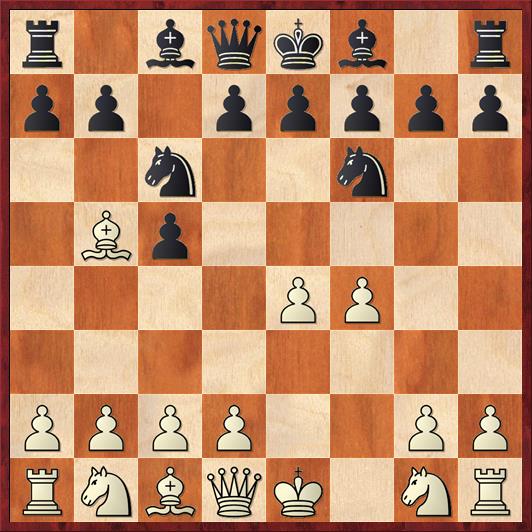 Position after 3. … Nf6. White to move.
Position after 3. … Nf6. White to move.
FEN:r1bqkb1r/pp1ppppp/2n2n2/1Bp5/4PP2/8/PPPP2PP/RNBQK1NR w KQkq – 0 4
Game 1: Invite Everyone to the Party
In this game I set Shredder’s strength at 2059. That’s lower than I usually set it, but I was feeling discouraged after a run of losses. Nevertheless, the opening play was pretty good on both sides, except for one move. The moves were
4. e5 Nd5 5. Nf3?! a6?!
Believe it or not, I simply forgot that my pawn on f4 was en prise. And then, equally unbelievably, Shredder didn’t take it. I would get a little bit of compensation after 5. … Nxf4 6. O-O, but probably not a pawn’s worth. A more sensible move order would have been 5. d3 a6 6. Bxc6 dc 7. Nf3, reaching the same position as in the game.
6. Bxc6 dc 7. d3 g6 8. Nc3 Nxc3 9. bc Bg7 10. c4 b5 11. Be3 bc 12. dc Qa5+ 13. Qd2 Qa4 14. Bxc5 Qxc4 15. Qd4 …
I was starting to feel pretty good here. If Shredder trades queens it’s probably equal, but I felt that I was on the better side of equal, as my minor pieces are more active.
15. … Qxc2?!
Too optimistic. Too greedy. It seems ironic that Shredder would snatch a pawn here but not on move five. It has no consistency; it can play cautiously one moment and recklessly the next.
Actually, humans can be pretty inconsistent, too. So maybe this is a sign that Shredder is human-like.
16. O-O Be6?
This was the decisive mistake. According to Rybka, 16. … Bf5 is still playable.
17. Rfc1 Qe2
Now do you see White’s combination? Can you analyze it all the way?
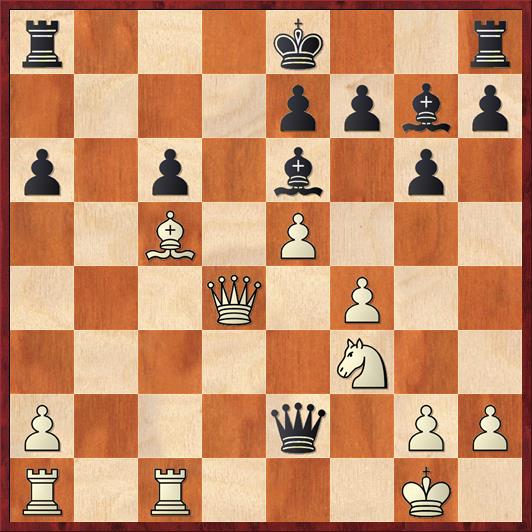 Position after 17. … Qe2. White to move.
Position after 17. … Qe2. White to move.
FEN: r3k2r/4ppbp/p1p1b1p1/2B1P3/3Q1P2/5N2/P3q1PP/R1R3K1 w kq – 0 18
Space inserted in case you want to think…
The move I played here was 18. Bxe7! This is actually a “safe sacrifice,” the kind of sacrifice where it’s very easy to see that White has at least a perpetual check. So it’s possible (especially in a blitz game) to play it first and analyze later, when you get to the moment when you actually have to decide between playing for a draw and playing for a win.
In fact, the computer should not have accepted the sac, but if it declines (say, with 18. … Bd5) White clearly has the upper hand because Black’s king is caught in the center.
But Shredder did take and allowed me to play the rest of the combination:
18. … Kxe7? 19. Qd6+ Ke8 20. Qxc6+ Ke7 21. Qd6+ Ke8 22. Rc7! …
Eschewing the draw to play for a win. Black’s moves continue to be forced.
22. … Bf8 23. Qc6+ Kd8 24. R1c1 …
Also winning is 24. Qxa8+, but it’s a bit tricky. After 24. … Kxc8 25. Qxa7+ Kc6 I saw to my dismay that the fork 26. Nd4+? is no good because of 26. … Kd5 27. Nxe2 Bc5+. This is the sort of unbelievable resource that computers always manage to come up with. I missed the fact that 26. Rc1+! (instead of 26. Nd4+) ends the game on the spot. If 26. … Kd5 27. Qd4 mate, and if 26. … Kb5 27. Nd4+ forks the king and queen without allowing Black to equalize afterwards with … Bc5+.
Nevertheless, I wouldn’t call 24. R1c1 a mistake. It’s very principled, bringing all of White’s pieces into the attack.
24. … Rb8
And now I miss the easy winning move.
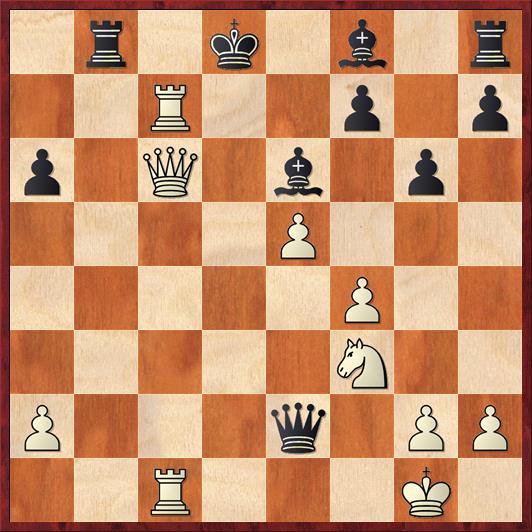 Position after 24. … Rb8. White to move.
Position after 24. … Rb8. White to move.
FEN: 1r1k1b1r/2R2p1p/p1Q1b1p1/4P3/5P2/5N2/P3q1PP/2R3K1 w – – 0 25
It wasn’t Shredder that got me, but hubris. I thought I had another brilliant sacrifice.
25. Rd7+?? Bxd7 26. Qc7+ Ke8 27. Qxb8+ Ke7 28. Qd6+ Ke8 1/2-1/2
Here my intention had been to play 29. Qf6, but then I realized with horror that my rook drops after 29. … Qe3+. So I had to bail out into a draw by repetition.
The correct move in diagram 3 is so easy that I was ashamed to have missed it. You just need to remember to invite all your pieces to the party. The knight isn’t doing anything, so let’s bring it into the attack!
After 25. Ng5! the threat is Nxe6 followed by Qd7 mate. Black’s only reasonable defense is to give up his queen with 25. … Qe3+ 26. Kh1 Qxc1+ 27. Qxc1. The game isn’t quite over, but after 27. … Bxa2 28. Nxf7+! Bxf7 29. Rxf7 Black is obviously in super deep trouble.
This was a very discouraging finish to what could have been a really nice game. But little did I realize I would get my chance for revenge a week later!
Game 2: Revenge is Sweet
In this game Shredder’s strength was set a little bit higher, at 2156. Nevertheless, we both played worse than in game 1. Beginning with diagram 1, the game continued:
4. Bxc6 …
I thought this might be an improvement over 4. e5. Probably not.
4. … dc 5. Qe2 g6 6. Nf3 Bh6 7. d3 Nh5 8. g3 Bg4
The way that Black played this line strikes me as very computer-like, but it was effective. It’s gotten me to create a weakness (8. g3) and now I create a whole bunch more.
9. Be3? …
 Position after 9. Be3. Black to move.
Position after 9. Be3. Black to move.
FEN: r2qk2r/pp2pp1p/2p3pb/2p4n/4PPb1/3PBNP1/PPP1Q2P/RN2K2R b KQkq – 0 9
I took about one second to play this move. It’s semi-blitz chess, after all (game/10, with one timeout). I’m sure I wouldn’t make this mistake in a tournament game, but it does point out a recurrent problem I have in the Grand Prix Sicilian, which Gjon Feinstein has pointed out to me. I am too eager to develop my bishop to e3. It’s like a nervous tic: I see a weak square there and I want to plug it. (Better would have been 9. Nbd2.)
9. … Qb6! 10. b3 Bg7!
Oh, no. You mean to tell me that bishops can move backwards?
11. c3 Rd8 12. O-O Qa6 13. Qf2 Qxd3 14. Bxc5 Qxe4? 15. Nbd2? …
As I said, this isn’t the greatest game for either player. Both sides underestimated 15. Re1, which forces Black to give up his queen for a rook and knight (plus the pawn he has already won): 15. … Bxc3 16. Rxe4 Bxe4 17. Qe2 f5 with rough equality, according to Rybka.
15. … Qc2 16. Rfe1 Rd7?
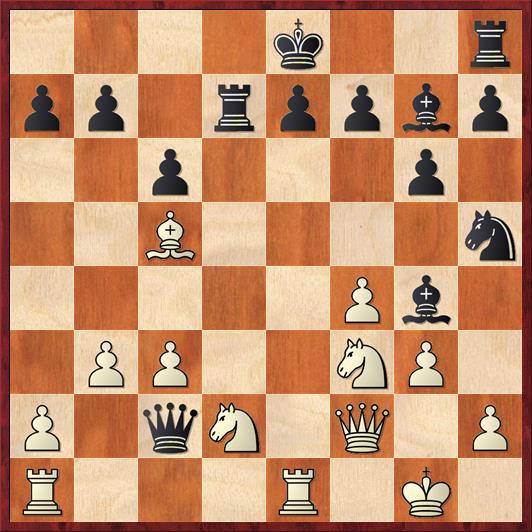 Position after 16. … Rd7. White to move.
Position after 16. … Rd7. White to move.
FEN: 4k2r/pp1rppbp/2p3p1/2B4n/5Pb1/1PP2NP1/P1qN1Q1P/R3R1K1 w k – 0 17
I couldn’t believe it! You mean it’s letting me play the same sacrifice as last time? Of course, the computer has no memory of our earlier game.
Here I should have taken my Matrix chess timeout, to control my emotions, make sure that the sacrifice is sound, and work out the correct followup. However, my attitude was that my position was already coming unglued, and if I play a “normal” move I would just suffer for a long time and lose. I might as well have a little bit of fun.
17. Bxe7! Rxe7 18. Rxe7+? …
Oh, no! The “automatic recapture,” which I wrote about in a recent post, rears its ugly head again. To me, this move was a no-brainer, because I’m trying to expose Black’s king. So I was startled when I went over the game afterwards with Rybka, and it said “18. Qxa7 = (0.00).”
The point of 18. Qxa7! is to keep more tension in the position and put the onus on Black to decide what to do about the rooks. (Also it starts the tedious but necessary process of mopping up Black’s pawns.) White threatens to win a whole rook with 19. Qb8+ Kd7 20. Qxb7+. Black absolutely cannot survive after 18. … Rxe1+ 19. Rxe1+. So he’s got to play something like 18. … Qd3 19. Qb8+ Qd8 20. Rxe7+ Kxe7 21. Re1+ Be6 22. Qxb7+ Kf8 23. Qxc6. This is the position that Rybka confidently assesses as 0.00, dead equal. I would not have a similar degree of confidence. White has three connected passed pawns for a bishop, but Black’s two bishops look pretty menacing. Still, there is no question that this was the correct way for White to play. Remember, I was a pawn down and reeling before the bishop sac. In the above line I win four pawns (!) for the bishop, right the ship and now I have a fighting chance to win.
After my “automatic recapture” 18. Rxe7+?, Rybka says that Black should be winning.
18. … Kxe7 19. Qc5+ Kd7 20. Re1 Kc8 21. Re7 …
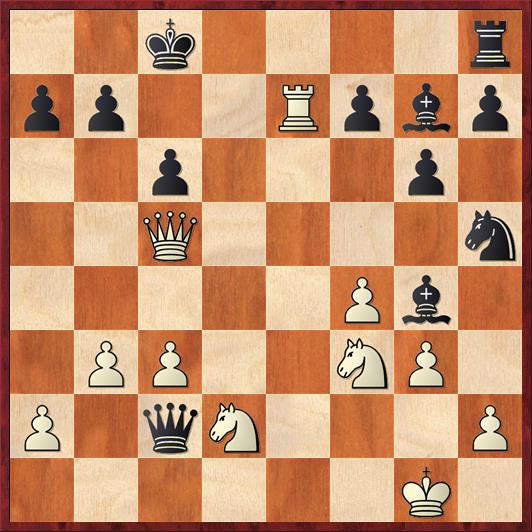 Position after 21. Re7. Black to move.
Position after 21. Re7. Black to move.
FEN: 2k4r/pp2Rpbp/2p3p1/2Q4n/5Pb1/1PP2NP1/P1qN3P/6K1 b – – 0 21
The position is by no means easy for Black to defend. For example, 21. … Kb8? (running for the corner) would be met by 22. Ne5! with the killing threat of Nxc6+, and if 22. … Bxe5 then 23. Qxe5+ would pick up the rook on h8, with mate to follow.
I should say that it’s by no means easy for a human to defend this position. For a computer, it should be a piece of cake. Rybka finds two moves that are completely winning for Black. One of them is 21. … Bf6, luring my rook into a trap after 22. Rxf7? Be6. The other defense is 21. … Qxa2, a dead simple move that defends one entry square (a7) immediately, and then defends the other (c7) after 22. Qd6 Qa5.
Instead Shredder played the greedy move, 21. … Bxf3??, which wins a piece but loses the game. I have no doubt that it played this awful blunder because I had set its strength below its maximum. I’ve never been sure how that feature works exactly, whether lowering its rating changes its evaluation function or whether it randomly chooses the second-best or third-best move now and then, with catastrophic results if the third-best move is no good. If I were playing a human, I would say that the pressure of my speculative attack was too much for my opponent. But because Shredder is a computer, all I can say is that I got lucky.
Shredder’s in-game evaluation after 21. … Bxf3 was that Black is ahead by 3.64 pawns. In reality, Black is busted.
22. Qxa7 Qd1+ 23. Nf1 …
It’s kind of cute how White’s beleaguered pieces defend everything — the knight blocking the back rank, the pawn on c3 and queen on a7 somehow combining to protect d4.
23. … Kd8 24. Rxb7 …
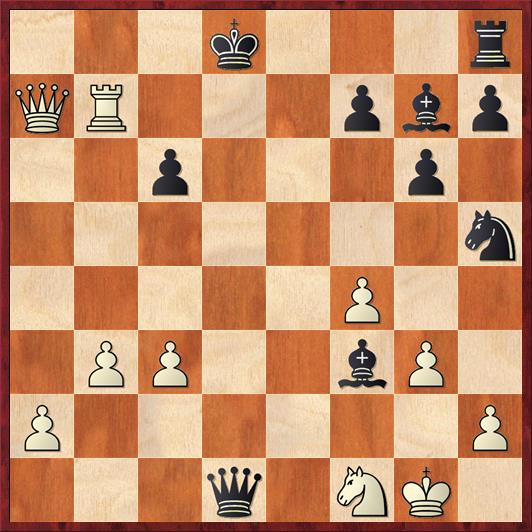 Position after 24. Rxb7. Black to move.
Position after 24. Rxb7. Black to move.
FEN: 3k3r/QR3pbp/2p3p1/7n/5P2/1PP2bP1/P6P/3q1NK1 b – – 0 24
Actually, the last move is where I belatedly took my time-out, because I wanted to work out whether Rxb7 or Rxf7 was better. However, it wasn’t much of a decision once I saw that 24. Rxb7 leads to mate. For instance, if 24. … Bg4 25. Qb8+ Bc8 26. Qc7+ or if 24. … Ke8 25. Qe3+! Kf8 26. Qe7+. In both cases the trick is for White to get his queen in front of the rook.
That’s how the game should have ended, or else it should have ended with a resignation that would have given me a miniature (a win in 25 moves or less). Instead, the computer did its spoiled-brat imitation and started giving away material: 24. … Bd4+ 25. cd Qxf1+ 26. Kxf1 1-0.
An imperfect game but I hope you agree it was an entertaining one! Also, of course, we learn from our mistakes and there is a lot to be learned here — from my bad habit of playing Be3 prematurely to my bad habit of playing automatic recaptures.


